Removal of a single alpha-tubulin gene intron suppresses cell cycle arrest phenotypes of splicing factor mutations in Saccharomyces cerevisiae
- PMID: 11784857
- PMCID: PMC133559
- DOI: 10.1128/MCB.22.3.801-815.2002
Removal of a single alpha-tubulin gene intron suppresses cell cycle arrest phenotypes of splicing factor mutations in Saccharomyces cerevisiae
Abstract
Genetic and biochemical studies of Schizosaccharomyces pombe and Saccharomyces cerevisiae have identified gene products that play essential functions in both pre-mRNA splicing and cell cycle control. Among these are the conserved, Myb-related CDC5 (also known as Cef1p in S. cerevisiae) proteins. The mechanism by which loss of CDC5/Cef1p function causes both splicing and cell cycle defects has been unclear. Here we provide evidence that cell cycle arrest in a new temperature-sensitive CEF1 mutant, cef1-13, is an indirect consequence of defects in pre-mRNA splicing. Although cef1-13 cells harbor global defects in pre-mRNA splicing discovered through intron microarray analysis, inefficient splicing of the alpha-tubulin-encoding TUB1 mRNA was considered as a potential cause of the cef1-13 cell cycle arrest because cef1-13 cells arrest uniformly at G(2)/M with many hallmarks of a defective microtubule cytoskeleton. Consistent with this possibility, cef1-13 cells possess reduced levels of total TUB1 mRNA and alpha-tubulin protein. Removing the intron from TUB1 in cef1-13 cells boosts TUB1 mRNA and alpha-tubulin expression to near wild-type levels and restores microtubule stability in the cef1-13 mutant. As a result, cef1-13 tub1Deltai cells progress through mitosis and their cell cycle arrest phenotype is alleviated. Removing the TUB1 intron from two other splicing mutants that arrest at G(2)/M, prp17Delta and prp22-1 strains, permits nuclear division, but suppression of the cell cycle block is less efficient. Our data raise the possibility that although cell cycle arrest phenotypes in prp mutants can be explained by defects in pre-mRNA splicing, the transcript(s) whose inefficient splicing contributes to cell cycle arrest is likely to be prp mutant dependent.
Figures
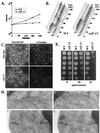

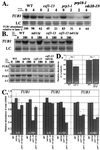
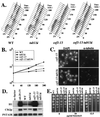
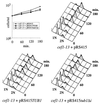
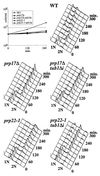
Similar articles
-
Genome-wide analysis of pre-mRNA splicing: intron features govern the requirement for the second-step factor, Prp17 in Saccharomyces cerevisiae and Schizosaccharomyces pombe.J Biol Chem. 2004 Dec 10;279(50):52437-46. doi: 10.1074/jbc.M408815200. Epub 2004 Sep 27. J Biol Chem. 2004. PMID: 15452114
-
Dependence of pre-mRNA introns on PRP17, a non-essential splicing factor: implications for efficient progression through cell cycle transitions.Nucleic Acids Res. 2003 May 1;31(9):2333-43. doi: 10.1093/nar/gkg333. Nucleic Acids Res. 2003. PMID: 12711678 Free PMC article.
-
Mutations in genes of Saccharomyces cerevisiae encoding pre-mRNA splicing factors cause cell cycle arrest through activation of the spindle checkpoint.Nucleic Acids Res. 2002 Oct 15;30(20):4361-70. doi: 10.1093/nar/gkf563. Nucleic Acids Res. 2002. PMID: 12384582 Free PMC article.
-
Pre-mRNA splicing in yeast.Trends Genet. 1991 Mar;7(3):79-85. doi: 10.1016/0168-9525(91)90276-V. Trends Genet. 1991. PMID: 2031287 Review.
-
Regulated pre-mRNA splicing: the ghostwriter of the eukaryotic genome.Biochim Biophys Acta. 2012 Jun;1819(6):538-45. doi: 10.1016/j.bbagrm.2011.12.011. Epub 2012 Jan 9. Biochim Biophys Acta. 2012. PMID: 22248620 Free PMC article. Review.
Cited by
-
Differential expression and alternative splicing of cell cycle genes in imatinib-treated K562 cells.Tumour Biol. 2015 Sep;36(10):8127-36. doi: 10.1007/s13277-015-3493-0. Epub 2015 May 17. Tumour Biol. 2015. PMID: 25983000
-
The Prp19 complex and the Usp4Sart3 deubiquitinating enzyme control reversible ubiquitination at the spliceosome.Genes Dev. 2010 Jul 1;24(13):1434-47. doi: 10.1101/gad.1925010. Genes Dev. 2010. PMID: 20595234 Free PMC article.
-
Isolation of mutant alleles of the U6 snRNA m 6 A methyltransferase Mtl16 and characterization of their genetic interactions with splicing mutants in Schizosaccharomyces pombe.MicroPubl Biol. 2023 Aug 11;2023:10.17912/micropub.biology.000948. doi: 10.17912/micropub.biology.000948. eCollection 2023. MicroPubl Biol. 2023. PMID: 37637271 Free PMC article.
-
Therapy-induced stress response is associated with downregulation of pre-mRNA splicing in cancer cells.Genome Med. 2018 Jun 27;10(1):49. doi: 10.1186/s13073-018-0557-y. Genome Med. 2018. PMID: 29950180 Free PMC article.
-
Suppressors of the cdc-25.1(gf)-associated intestinal hyperplasia reveal important maternal roles for prp-8 and a subset of splicing factors in C. elegans.RNA. 2008 Dec;14(12):2618-33. doi: 10.1261/rna.1168408. Epub 2008 Oct 22. RNA. 2008. PMID: 18945809 Free PMC article.
References
-
- Albright, S. R., and R. Tjian. 2000. TAFs revisited: more data reveal new twists and confirm old ideas. Gene 242:1–13. - PubMed
-
- Apone, L. M., C. M. Virbasius, J. C. Reese, and M. R. Green. 1996. Yeast TAF(II)90 is required for cell-cycle progression through G2/M but not for general transcription activation. Genes Dev. 10:2368–2380. - PubMed
-
- Archer, J. E., L. R. Vega, and F. Solomon. 1995. Rbl2p, a yeast protein that binds to beta-tubulin and participates in microtubule function in vivo. Cell 82:425–434. - PubMed
Publication types
MeSH terms
Substances
Grants and funding
LinkOut - more resources
Full Text Sources
Other Literature Sources
Molecular Biology Databases
Research Materials
